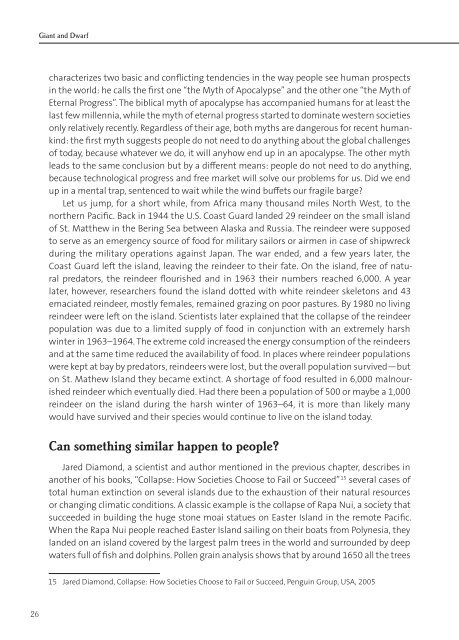Giant_and_Dwarf-FIN
Giant_and_Dwarf-FIN
Giant_and_Dwarf-FIN
Create successful ePaper yourself
Turn your PDF publications into a flip-book with our unique Google optimized e-Paper software.
<strong>Giant</strong> <strong>and</strong> <strong>Dwarf</strong>characterizes two basic <strong>and</strong> conflicting tendencies in the way people see human prospectsin the world: he calls the first one “the Myth of Apocalypse” <strong>and</strong> the other one “the Myth ofEternal Progress”. The biblical myth of apocalypse has accompanied humans for at least thelast few millennia, while the myth of eternal progress started to dominate western societiesonly relatively recently. Regardless of their age, both myths are dangerous for recent humankind:the first myth suggests people do not need to do anything about the global challengesof today, because whatever we do, it will anyhow end up in an apocalypse. The other mythleads to the same conclusion but by a different means: people do not need to do anything,because technological progress <strong>and</strong> free market will solve our problems for us. Did we endup in a mental trap, sentenced to wait while the wind buffets our fragile barge?Let us jump, for a short while, from Africa many thous<strong>and</strong> miles North West, to thenorthern Pacific. Back in 1944 the U.S. Coast Guard l<strong>and</strong>ed 29 reindeer on the small isl<strong>and</strong>of St. Matthew in the Bering Sea between Alaska <strong>and</strong> Russia. The reindeer were supposedto serve as an emergency source of food for military sailors or airmen in case of shipwreckduring the military operations against Japan. The war ended, <strong>and</strong> a few years later, theCoast Guard left the isl<strong>and</strong>, leaving the reindeer to their fate. On the isl<strong>and</strong>, free of naturalpredators, the reindeer flourished <strong>and</strong> in 1963 their numbers reached 6,000. A yearlater, however, researchers found the isl<strong>and</strong> dotted with white reindeer skeletons <strong>and</strong> 43emaciated reindeer, mostly females, remained grazing on poor pastures. By 1980 no livingreindeer were left on the isl<strong>and</strong>. Scientists later explained that the collapse of the reindeerpopulation was due to a limited supply of food in conjunction with an extremely harshwinter in 1963–1964. The extreme cold increased the energy consumption of the reindeers<strong>and</strong> at the same time reduced the availability of food. In places where reindeer populationswere kept at bay by predators, reindeers were lost, but the overall population survived—buton St. Mathew Isl<strong>and</strong> they became extinct. A shortage of food resulted in 6,000 malnourishedreindeer which eventually died. Had there been a population of 500 or maybe a 1,000reindeer on the isl<strong>and</strong> during the harsh winter of 1963–64, it is more than likely manywould have survived <strong>and</strong> their species would continue to live on the isl<strong>and</strong> today.Can something similar happen to people?Jared Diamond, a scientist <strong>and</strong> author mentioned in the previous chapter, describes inanother of his books, “Collapse: How Societies Choose to Fail or Succeed” 15 several cases oftotal human extinction on several isl<strong>and</strong>s due to the exhaustion of their natural resourcesor changing climatic conditions. A classic example is the collapse of Rapa Nui, a society thatsucceeded in building the huge stone moai statues on Easter Isl<strong>and</strong> in the remote Pacific.When the Rapa Nui people reached Easter Isl<strong>and</strong> sailing on their boats from Polynesia, theyl<strong>and</strong>ed on an isl<strong>and</strong> covered by the largest palm trees in the world <strong>and</strong> surrounded by deepwaters full of fish <strong>and</strong> dolphins. Pollen grain analysis shows that by around 1650 all the trees15 Jared Diamond, Collapse: How Societies Choose to Fail or Succeed, Penguin Group, USA, 200526


